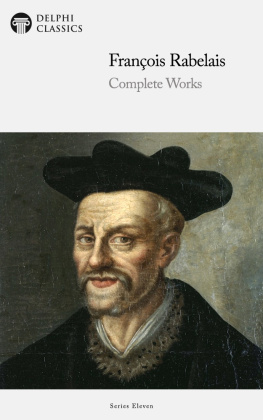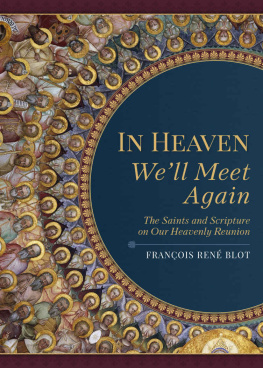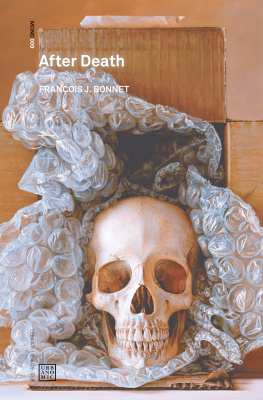
The Complete Works of
FRANOIS RABELAIS
(c. 1483-1553)

Contents

Delphi Classics 2020
Version 1


Browse our Main Series

Browse our Ancient Classics

Browse our Poets

Browse our Art eBooks

Browse our Classical Music series

The Complete Works of
FRANOIS RABELAIS

By Delphi Classics, 2020
COPYRIGHT
Complete Works of Franois Rabelais

First published in the United Kingdom in 2020 by Delphi Classics.
Delphi Classics, 2020.
All rights reserved. No part of this publication may be reproduced, stored in a retrieval system, or transmitted, in any form or by any means, without the prior permission in writing of the publisher, nor be otherwise circulated in any form other than that in which it is published.
ISBN: 978 1 91348 743 0
Delphi Classics
is an imprint of
Delphi Publishing Ltd
Hastings, East Sussex
United Kingdom
Contact: sales@delphiclassics.com

www.delphiclassics.com

Explore the French Masters at Delphi Classics

The Life of Gargantua and of Pantagruel

A 1699 print of La Devinire, an estate in Seuilly in the modern-day Indre-et-Loire, France the supposed birthplace of Rabelais

La Devinire, today

La Devinire, Muse Rabelais
Pantagruel (1532)

Translated by Thomas Urquhart
Illustrated by Gustave Dor
We remain uncertain of the place or date of birth of Franois Rabelais. Some scholars place the date as early as 1483, though he was likely born in November 1494 near Chinon, in the province of Touraine, where his father was employed as a lawyer. In his youth, Rabelais became a novice of the Franciscan order and later a friar at Fontenay-le-Comte in Poitou, where he studied Greek and Latin, as well as science, philology and law. Frustrated with the Franciscan orders ban on the study of Greek (partly due to Erasmus commentary on the Gospel of Saint Luke) Rabelais petitioned Pope Clement VII and gained permission to leave the Franciscans and to enter the Benedictine order at Maillezais in Poitou, where he was received warmly.
In time, he left the monastery to study medicine at the University of Poitiers and at the University of Montpellier. He then moved to Lyon, an intellectual centre of the Renaissance, and in 1534 he commenced his occupation as a doctor at the hospital, for which he earned 40 livres a year. During his time, he edited Latin works for the printer Sebastian Gryphius and wrote a famous admiring letter to Erasmus to accompany the transmission of a Greek manuscript from the printer. As a physician, he used his spare time to write and publish humorous pamphlets critical of established authority, much preoccupied with the educational and monastic mores of the time.
In 1532, under the pseudonym Alcofribas Nasier (an anagram of Franois Rabelais), he published his first book, Pantagruel King of the Dipsodes , the first of his Gargantua series. This pentalogy of novels tells the adventures of two giants, Gargantua and his son Pantagruel, written in a satirical vein. The novels reveal much erudition, vulgarity and a penchant for wordplay. Rabelais is regarded as an important polyglot and his work introduced many new and complicated words into the French language, similar to Shakespeares influence on the English language. Following its publication, Pantagruel was stigmatised as obscene by the censors of the Collge de la Sorbonne and, within a social climate of increasing religious oppression in the lead up to the French Wars of Religion, it was treated with suspicion and Rabelais contemporaries avoided mentioning the book.
Rabelais series of novels is outstanding for its rich use of Renaissance French and its range of comedic registers, from the gross burlesque to profound satire. The novels exploit popular legends, farces and romances, as well as classical and Italian texts, though it is important to remember that they were written primarily for a court public and a learned audience. Therefore, the common day adjective Rabelaisian , which can be applied to scatological humour, is somewhat misleading. Later critics have pointed out how Rabelais employed scatology for aesthetic purposes, not gratuitously, but instead for comic condemnation. Widely celebrated for their creative exuberance, colourful vocabulary and literary variety, Rabelais works have remained enduring classics throughout the ensuing centuries.
The full modern English title for the first novel is The Horrible and Terrifying Deeds and Words of the Very Renowned Pantagruel King of the Dipsodes, Son of the Great Giant Gargantua . The narrative begins with the origin of giants, tracing Pantagruels particular genealogy and his birth. His childhood is briefly covered, before his father sends him away to study at university, where he acquires a great reputation. On receiving news that his father has been translated to Fairyland by Morgan le Fay and that the Dipsodes have invaded his land, Pantagruel and his companions set off to the rescue
Next page






























